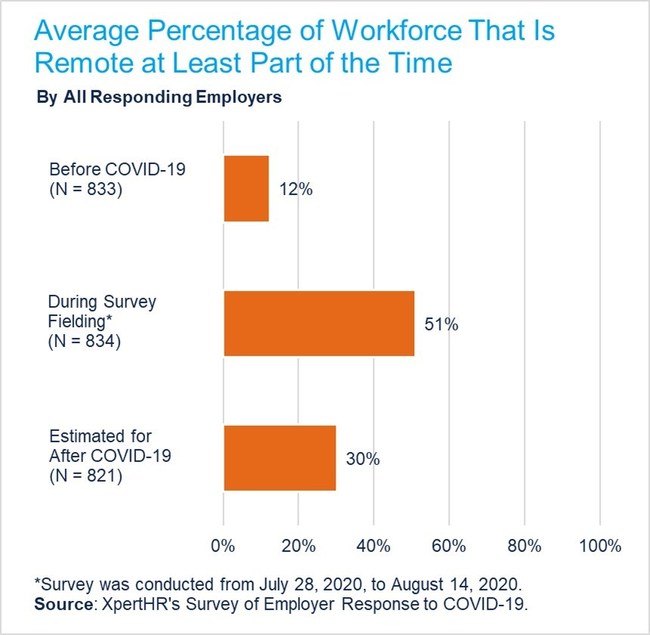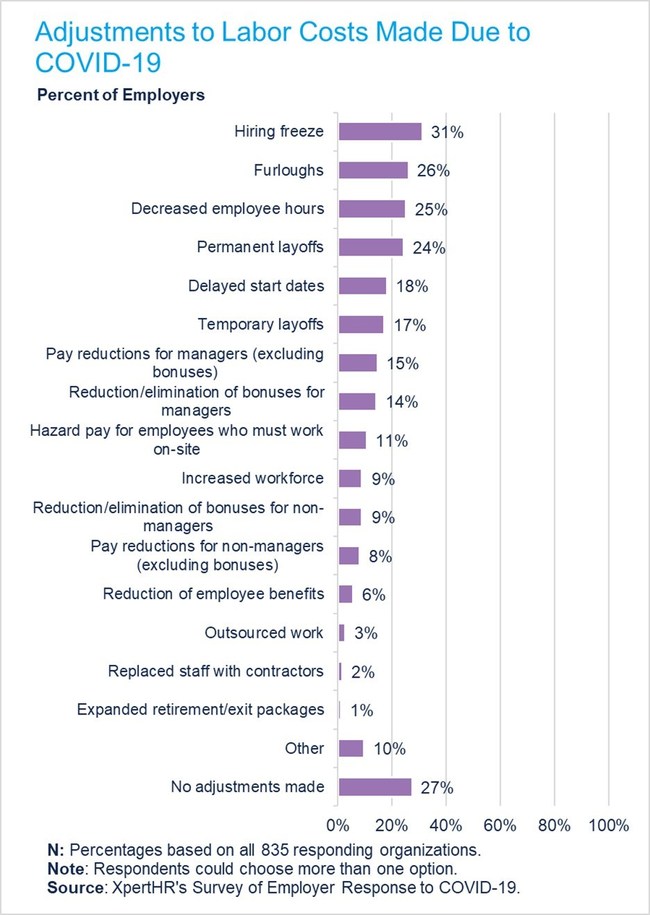
25 Sep, 2020
Remote work set to nearly triple in post-Covid world, reports XpertHR Survey
“COVID-19 will shape the working world for years to come, in particular contributing to a rise in remote work set to last beyond the end of the current health crisis. Given the tremendous strains placed on workers during the pandemic, such as fear of layoffs, isolation of remote work, increased caregiving and homeschooling responsibilities, and concern about contracting the disease itself, it comes as little surprise that maintaining employee morale has been a considerable challenge for employers.” Will this impact on Travel? For sure.
NEW PROVIDENCE, N.J., 22 September 2020, PRNewswire – The average percentage of employees who will work remotely at least part of the time is projected to nearly triple from 12% before the COVID-19 pandemic to 30% after the pandemic, according to 835 US employers responding to XpertHR’s Survey on Employer Response to COVID-19.

The average percentage of employees who will work remotely at least part of the time is projected to nearly triple from 12% before the COVID-19 pandemic to 30% after the pandemic.

The most common labor cost-saving measure has been the hiring freeze, which has been implemented at some point during the pandemic by 31% of the 835 responding employers.
During survey fielding—which was late July to mid-August 2020—an average of 51% of employees were working remotely, indicating that while remote working arrangements will be less common in the post-COVID environment than during the pandemic, they will remain elevated over pre-pandemic levels.
“It is clear that COVID-19 will shape the working world for years to come, in particular contributing to a rise in remote work set to last beyond the end of the current health crisis,” says Andrew Hellwege, Surveys Editor, XpertHR.
The survey also asked responding HR professionals to rate how challenging 10 COVID-19-related issues have been and found that maintaining employee morale has been the most difficult, with 76% of participants rating this as either “somewhat” or “very” challenging.
“Given the tremendous strains placed on workers during the pandemic, such as fear of layoffs, isolation of remote work, increased caregiving and homeschooling responsibilities, and concern about contracting the disease itself,” says Hellwege, “it comes as little surprise that maintaining employee morale has been a considerable challenge for employers.”
The survey sheds more light on the economic devastation caused by the novel coronavirus, as employers noted several ways they have cut labor costs due to the pandemic. The most common labor cost-saving measure has been the hiring freeze, which has been implemented at some point during the pandemic by 31% of the 835 responding employers, with furloughs (26%), decreased employee hours (25%), and permanent layoffs (24%) rounding out the top four measures. (The survey asked about several labor cost adjustments, and respondents could choose more than one.)
The report also discusses what measures employers are taking to support the wellness of their employees during these unprecedented times, and shows that offering flexible work schedules to allow for caregiving or homeschooling has been the most popular option, with 70% of responding employers taking this step. (The survey asked about several wellness measures and respondents could choose more than one.)
“There has been a clear need for more flexible work scheduling due to disruptions in childcare, schooling, and other routines in daily life,” notes Hellwege, “and the survey shows most employers have tried to provide this flexibility to help their employees adjust to the new normal.”
XpertHR’s Survey on Employer Response to COVID-19 was conducted from July 28, 2020, to August 14, 2020, and published on September 11, 2020. The survey includes the responses from 835 US employers of various industries and workforce sizes. The total estimated number of employees of responding organizations is 1,095,245. The survey report covers several topics, including workplace safety, remote work, labor cost adjustments, employee performance, employee wellness, and emergency preparedness planning.
To learn more visit xperthr.com



Liked this article? Share it!